Discussion on the “volumetric efficiency” of a tent might immediately cause some heavy eyelids, but it simply refers to how weight efficient a tent’s geometry is [I can already tell this post isn’t going to rank in my top 10]. Thus any outdoors person interested in lightweight gear should possess at least a cursory familiarity.
If the goal of a lightweight shelter is to provide living space at the lowest weight, then starting with a basic shape (or “geometry”) that uses the least material to provide that space should clearly be desirable (amongst numerous other criteria). So we are looking to optimize the volume:surface area ratio.
To introduce the topic and demonstrate how it can be non-intuitive, I will compare this volume:surface area ratio for two popular styles of trekking pole shelters against a tent of my own design – the X-Mid. The first popular tent geometry is a single pole pyramid with a rectangular base (the MLD DuoMid being a classic example). Single pole mids have a simple base shape (a rectangle) and the most simple possible structure (1 vertical pole) so intuitively many folks think this is the most efficient or the “lightest” design (if other attributes like fabric choice are equalized).
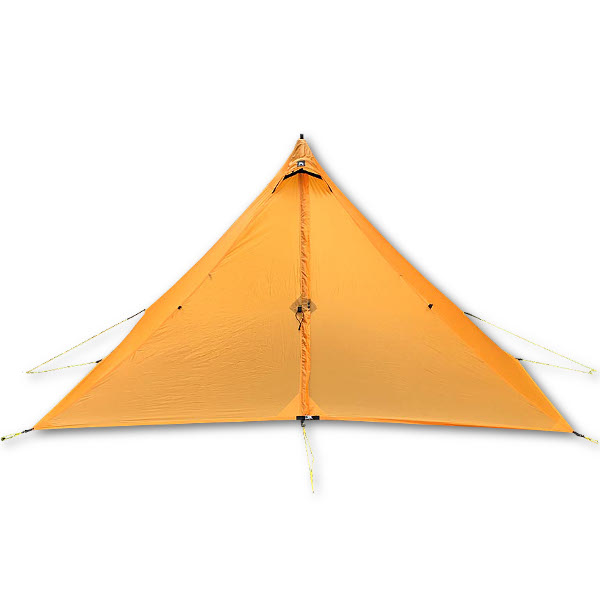
The second comparison is a standard “pup tent”. This tent is also based around a rectangle but uses two poles set nearly as far apart as possible. Obviously this increases the volume but also increases the surface area, so it’s unclear if it is more efficient in terms of the material required for the amount of living space (again the volume:surface area ratio).
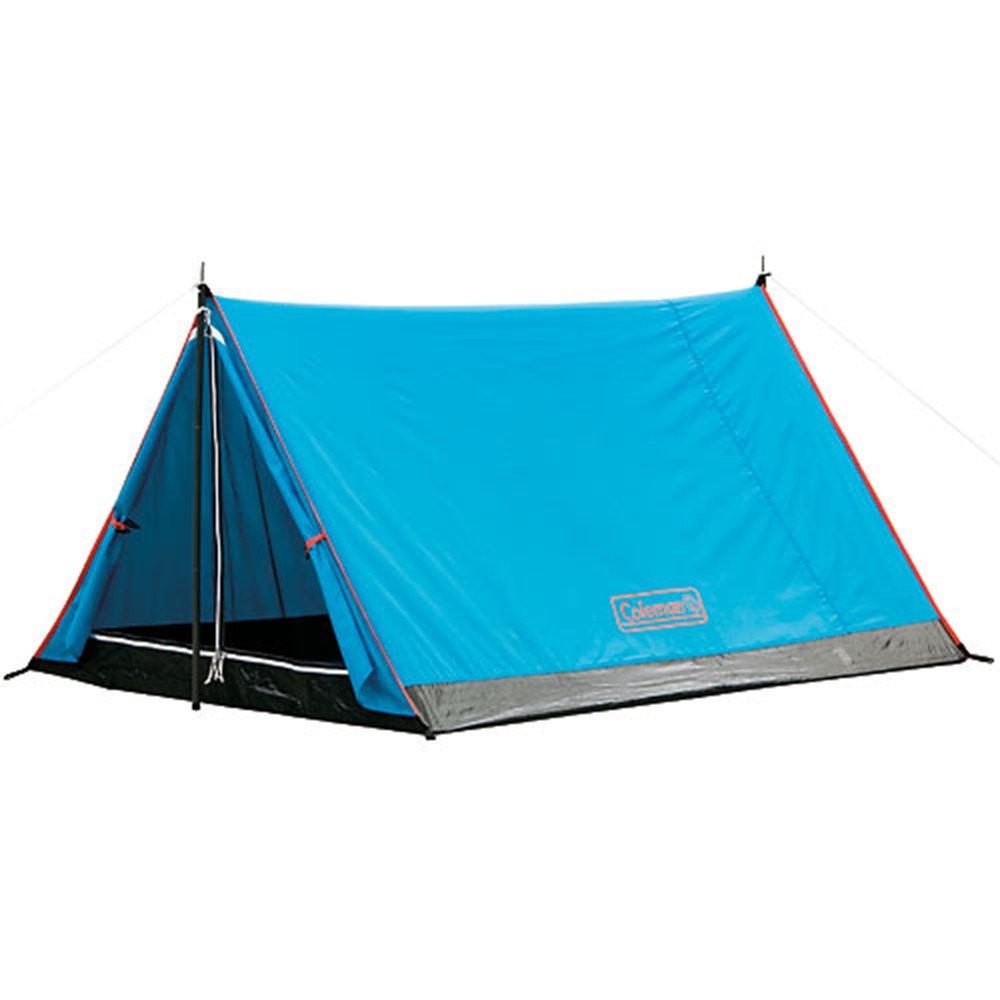
The last tent is my X-Mid design, which again uses a rectangle shape at the base but places the two poles at an internal position along a diagonal axis.
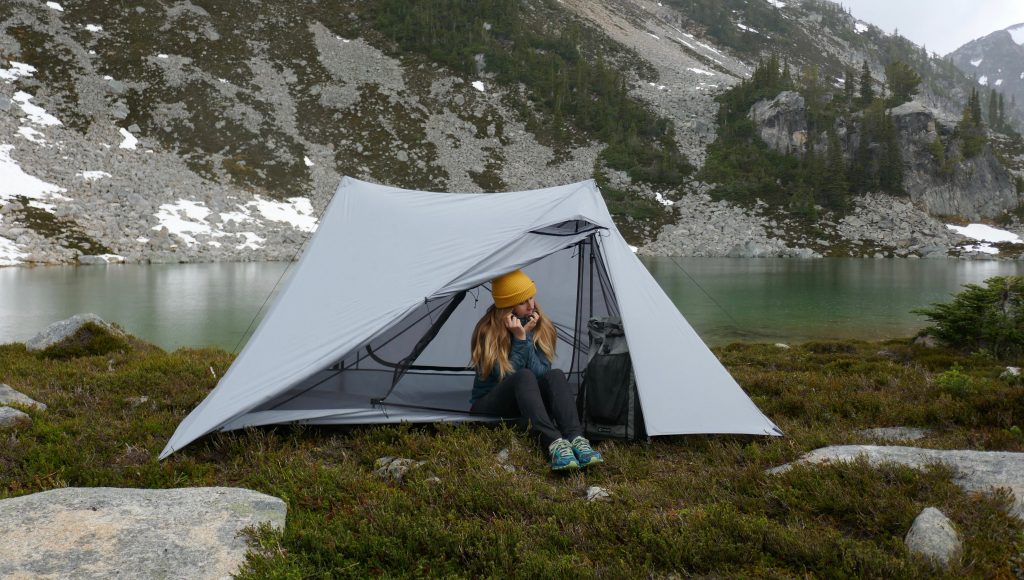
These poles are inset from the perimeter of the fly so the tent can pitch without the guylines required for the pup tent, and the poles are on a diagonal which avoids conflict in the doorways present on these other two shelters. The layout is like this:
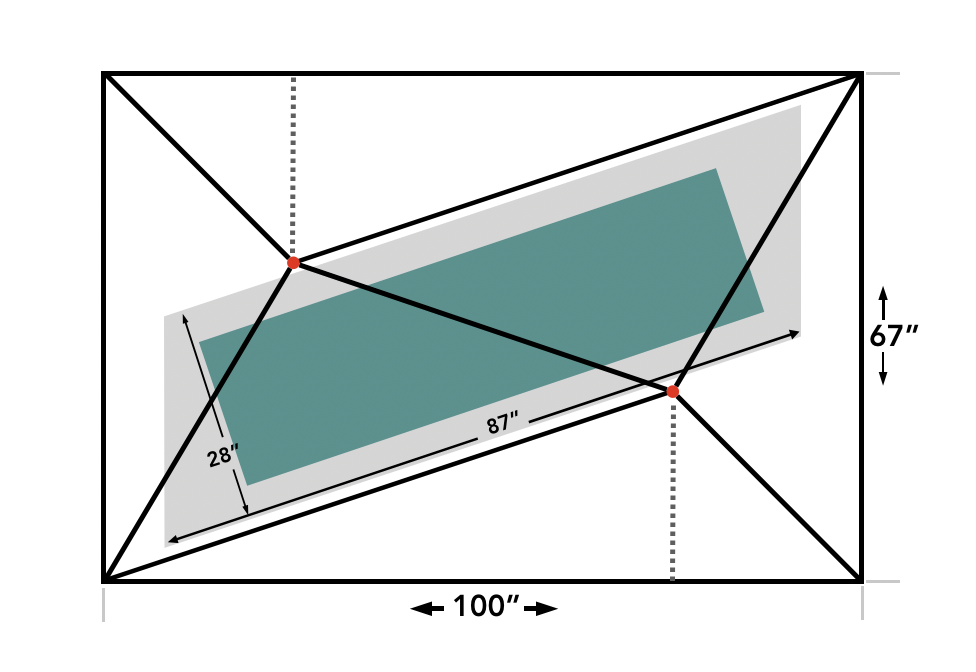
Readers with a fair recollection of high school geometry might already be able to guess the most efficient shape. As a hint, the best possible volume:surface area ratio is possessed by a sphere, as the graph below shows (area on the y-axis, volume on the x, lower lines are more efficient). The core message of this graph is that for any given volume, a sphere always has the least surface area. A second notable takeaway is how much worse the three sided shape is (which is partly why you don’t see 3 sided tents).
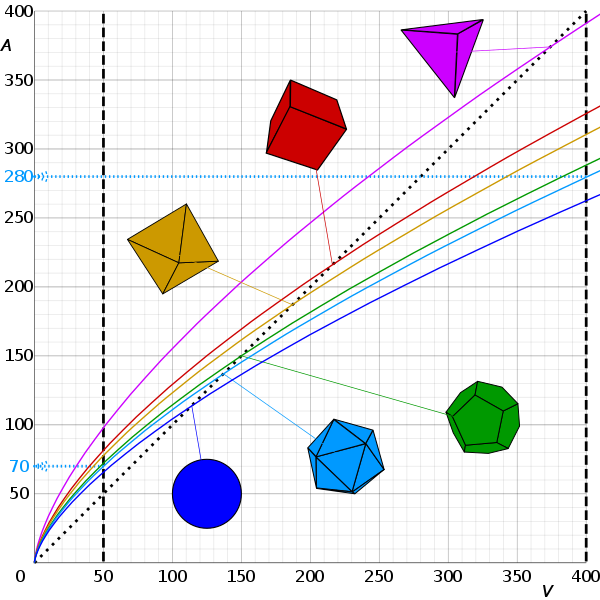
One last takeaway is that all of these shapes improve as the tent grows larger (e.g. for any shape you could double the volume without doubling the surface area). That can be seen by the downward curving lines for all shapes and is why any comparison needs to standardize one of these things to see how the other varies.
So what is the most efficient shape for a tent? It’s a dome tent because a floorless dome is just half of a sphere. A dome has half the volume of a sphere and also half the surface area (if we are not including the base since the floor could occupy any portion of that dome). Thus the ratio is just as good as a sphere and unlike a sphere, you can actually build a dome shaped tent.
But of course creating a tent that is both a perfect dome and trekking pole supported is impossible. You’d need to have a perfectly round base (requiring an infinite number of stakes) and a perfectly domed surface (requiring an infinite number of support poles). The interior would be an impenetrable cluster of trekking poles with no usable space (but amazingly robust).
At the other end of the spectrum we have the 3 sided triangular pyramid highlighted earlier for being distinctly poor. Is the simplest possible base shape as it has only 3 sides (and therefore 3 stakes) and requiring just 1 pole but with a dreadful surface area: volume ratio. Somewhere in between the minimal stake and structure requirements of the triangle and the maximal such requirements of a dome there is an optimum for a trekking pole tent. This optimum exists where you add more sides, stakes and seams until the diminishing returns no longer give a net weight savings on that investment (of course there are many other considerations as well, like how many poles a hiker might have and how a hiker might sleep within a maze of poles).
Back to our case study – below I have sketched out these three shelters to scale to show their geometry. To approximately equalize I have used the same base dimensions (100″ x 67″) for all of them and assigned the pole height at 54″ for the single pole shelter and 45″ for the dual pole shelters since these are typical values.

From these dimensions I calculated the volume and surface area of each shelter to get the volume:surface area ratio as you can see above. Note that the surface area excludes the floor since I am only calculating the material you would need to build a fly for this tent. Any floor wouldn’t necessarily have to use the full area of the base.
First, the single pole mid has a volume of 70 cubic feet and requires 78 square feet of fabric to build that, for a ratio of 0.89:1 (or 0.89 cubic feet of space from each square foot of fabric). Unsurprisingly the pup tent possesses more volume (by 24%) at 87 cubic feet but also requires 26% more fabric (99 vs 78 square feet) so it actually has slightly worse ratio of 0.88:1.
The X-Mid on the other hand possesses 16% more volume than the single pole mid despite only using 7% more material, so its volumetric efficiency is much better at 0.97:1. It gets almost a cubic foot of space from each square foot of fabric. In other words, if you were to scale these tents so they all have the same volume, the X-Mid would require 10% less material. Or if you built all of these shapes from the same amount of fabric, the X-Mid would have about 10% more volume. Thus of these three shapes, the X-Mid is easily the most weight efficient. This is also intuitively true now that we know that the shape closest to a dome is the most efficient and the X-Mid appears to be that.
While I’m biased as the X-Mid designer, I think it is the pinnacle of efficiency for a trekking pole tent because rectangular tents have superior efficiency over the more common hexagonal sided shape (discussed later), two poles can beat one pole as they can better approximate a dome, and the X-Mid layout is the only way to approximate a dome with two poles (e.g. not have the poles along the perimeter) while keeping the poles off the floor.
Back to the comparison – the dimensions I’ve used thus far for the single pole mid aren’t realistic because single pole mids have such low wall angles on the ends compared to the other two designs that they need a longer floor to allow for a decent length of sleeping area. Shown below are the actual dimensions of perhaps the most popular single pole pyramid (MLD DuoMid), which is 10″ longer than the X-Mid:
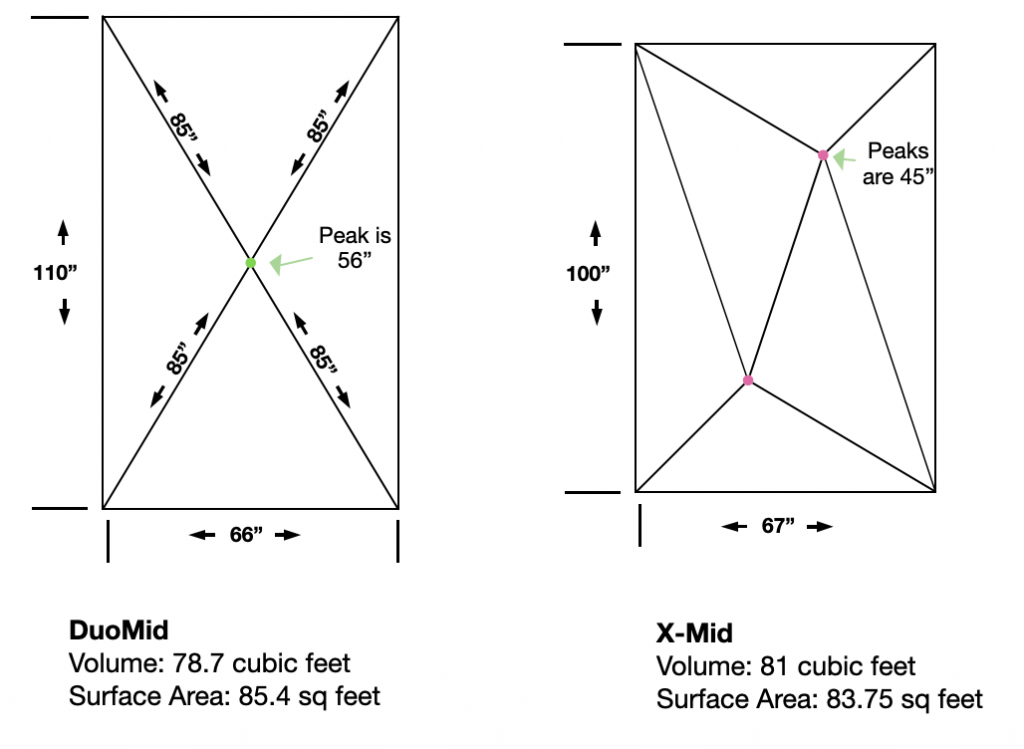
Here, we see that the DuoMid has less volume (79 vs 81 cubic feet) despite using more fabric (85 vs 84 square feet). Again this shows that single pole mids are less efficient designs. The X-Mid achieves more volume while using less fabric.
As a side point, while the longer length of the DuoMid looks better suited for tall hikers but this is not the case because the heavily sloping end walls result in very low and unusable area at the ends. Despite the DuoMid being 10″ longer (100″ vs 110″), the X-Mid is actually about 6″ longer if you look at the height about 15″ off the ground (where the top of a sleeping bag would be).
Now you might agree that the X-Mid is more volumetrically efficiency on paper but wish to point out that gleaning an extra 2.3 cubic feet from 1.5 square feet less of fabric is hardly substantial enough to celebrate. Indeed it would hardly show on the scale. However if we go beyond the total volume and look at where that volume is located, we can see that the X-Mid is far more spacious.
As mentioned, a single pole pyramid “wastes” about 5% of its volume at the perimeter of the base were the canopy is very low. A portion of a single pole mids volume isn’t “useable”. This is admittedly a subjective term, but for a definition let’s turn to Henry Shires – the most prolific trekking pole designer of the 21st century – for one he provided in his patent for the TarpTent StratoSpire:
“Useable space is space where the canopy walls are high enough above the ground so that the occupants and their gear are not pressing against or distorting the canopy walls while inside. I prefer to define useable space as the interior volume where all canopy fabric is 12” (inches) or more above the ground.”
Based on both subjective experience and that definition, the single pole pyramid has a lot of non-useable space. Conversely the X-Mid avoids the very low slopes of the end walls such that more of its volume is useable. Thus while the X-Mid has about 5% more total volume, it really has closer to 10% more “useable volume” – all in a smaller footprint with less fabric.
But even this doesn’t really reflect how the space feels in these shelters because if you actually sit in both of these shelters, you’ll find the X-Mid feels much larger. This occurs because the volume in a single pole mid is heavily biased towards the lower half. It does have a lot of volume but very little of it is in the top half. Headroom is sparse because the only high point is where the pole is and you can’t sit there.
Looking only at the volume in the upper half (let’s say above 24″), the single pole mid has a mere 15% of its volume above this point (about 12 cubic feet out of its 78 cubic feet total), whereas the X-Mid has about 35% (28 of 81 cubic feet). Thus the X-Mid volume in the upper half (aka “headroom”) is 2.5x that of a single pole mid and which is why it feels and is much more spacious. So to sum it up, the X-Mid has 5% more total volume, 10% more “useable volume” and 250% more “headroom” – all from less fabric.
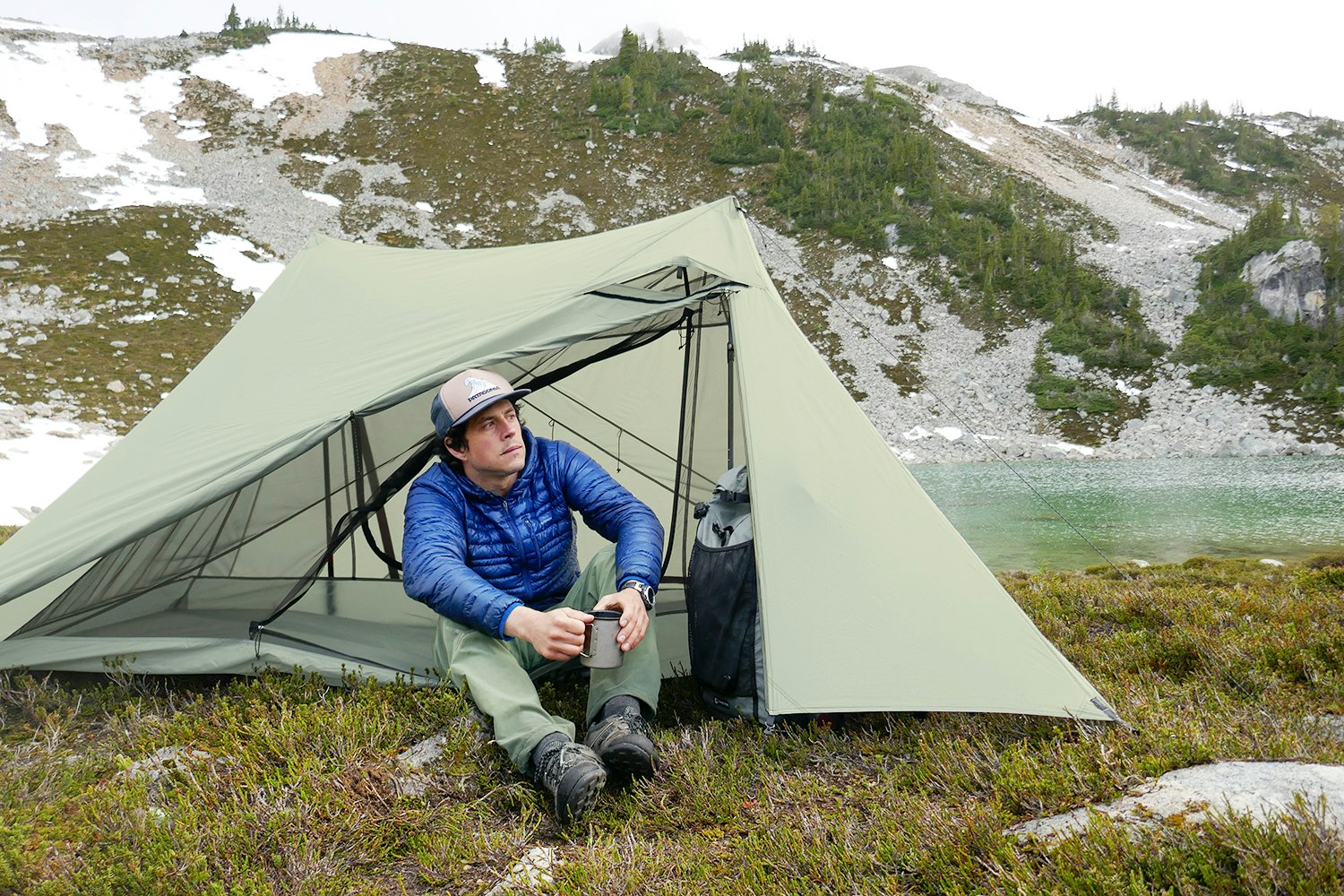
Next lets discuss how this compares to a dome tent and a wider range of popular designs for trekking pole shelters. The elephant in the room here are the tents with a hexagon base since these are quite popular and seemingly closer to a dome than the X-Mid.
We can assess this by circling back to my earlier statement that a dome is the most efficient shape. If you were to build a dome tent with the same 81 cubic foot volume as the X-Mid, you could do it with 72 square feet of fabric (rather than 83.75). So that’s a potential savings of 11.75 square feet or 1.3 square yards of fabric if you built a perfect dome. Lightweight materials today are 0.5 – 1.4oz per square yard, so the possible savings are 0.65 – 1.8oz. Thus any design that aims to be more efficient than the X-Mid needs to add seams, stakes, poles and/or struts to realize some of those dome inspired savings, without adding more weight than it saves.
The closest you might reasonably come to a trekking pole supported dome is an eight sided shelter supported by four trekking poles. The math here is complex but such a design turns out to be roughly halfway between the X-Mid and a dome in terms of fabric requirements. It would save about 6 sq ft of area (0.3 – 0.8oz of fabric) but also necessitate four more stakes which weight about 1.5oz – more than offsetting the fabric weight saved (plus there is further weight in the additional seams). Thus while the ratio of volume:surface area would improve, the volume:total shelter weight ratio would be worse. The same thing is true for a hexagonal shelters. They only marginally improve the volume:surface area ratio with a theoretical fabric weight savings of 0.2 – 0.5oz which will never translate into a net weight savings because two decent stakes weigh more than 0.5oz (and there are also additional seams). Thus any two pole hexagonal tent is going to be more complex and heavier for the same volume than a comparably sized rectangular based shelter.
On the flip side, what about about three sided shelter? If four is better than six, then perhaps three is better still? It is not. A possible three sided shelter would require a lot more fabric than a four sided one (scroll up to that graph earlier and notice how much worse a three sided shelter is than anything else) yet would only save the weight of one stake, so four sides much more efficient. Overall there is an optimum at 4-5 sides because seams and stake weight increases linearly for each side you add, while savings in fabric area are diminishing (a negative asymptote). The key result is that four sides is a big improvement over three, five is about equal to four, anything beyond is worse). Whether four or five is better is hard to say as the fabric area savings roughly equals the added seam and stake weight.
Lastly, you may wonder about the efficiency of the myriad of other trekking pole shelter shapes out there. In short, anything with a single pole that is off center (aka asymmetrical such as the SMD Lunar Solo) is always going to be less volumetrically efficient than the same thing with the pole positioned centrally (just from the basics of geometry). This is only done to get the pole out of the sleeping area. That’s why you’ll often see this type of shelter often adding various struts to increase volume or improve the distribution of that volume (e.g. supplement headroom), such as the TarpTent Aeon and Zpacks Plexamid. But these struts will always cause a further decline in the overall weight efficiency of the shelter because the additional volume you get relative to the weight of a strut is always poor. Adding weight via struts is fundamentally less efficient than using a second trekking pole if you have one on hand anyways, so those design only make sense for single trekking pole hikers. Single trekking pole tents can add enough struts to achieve a reasonably sized living space but it would be more weight efficient to start with a more efficient two pole geometry rather than tacking weight onto a less efficient one. Offset single pole designs with struts like the Plexamid and Aeon represent near the bottom of efficiency (but may have other advantages like a smaller footprint).
General Principles
The most weight efficient trekking pole tent will:
– Use a four or five sided shape
– 2 poles rather than 1
– Position the poles a moderate distance apart to approximate a dome shape
– Avoid struts
– Avoid asymmetry
Take home message
The worst case scenario for weight efficiency is to start with a shape with very few (3) or many sides (e.g. hexagon or octagon), add a single pole in an offset position and then add struts to that.
Conversely, the best case scenario is a two pole shelter based around a 4-5 sided shape and with the poles located at a moderate distance apart. Nothing is more volumetrically efficient than the X-Mid but some other two pole designs do come close like the Black Diamond Beta Light (below). Thus if you find a tent that is lighter than the X-Mid, it’s almost certainly not because of the geometry but rather because it is smaller, using lighter materials or less fully featured.

Very helpful, Dan. And my eyelids didn’t get heavy at all. How would the Tarptent Stratospire Li compare? And do their end struts make a difference?
Thanks.
Hi Dennis,
It’s difficult to explain the end struts effect on volumetric efficiency without some diagrams but I’ll take a shot. Also note that those “PitchLoc” corners affect more than just the volume. They also have both good and bad effects on wind and snow loading.
As for volume, if you were to take a normal corner of a trekking pole tent (e.g. any corner on a DuoMid) and then add a PitchLoc corner to that then certainly you’d get more volume at that corner but you would also add more weight. So more volume and more weight. Alternatively, you could instead achieve the same increase in volume by increasing the size of the tent (e.g. making the base larger). Actually I do need a diagram, so here is one that shows a regular corner, same corner plus a PitchLoc, or extending the fly further to achieve the same volume as the PitchLoc:
https://imgur.com/oxhALiW
Notice how the length of the green “PitchLoc” line is only a little bit shorter than the red “extended fly” line because the PitchLoc fabric still wraps around the corner and extends to the ground. So despite bringing in the edge of the fly perhaps a foot, the PitchLoc corner only saves a small amount of fabric versus the “extended fly” option to provide the same volume. Note that I am talking about “useable volume” here because the extended fly version adds more “total volume” than the PitchLoc corner but the additional volume on top of the PitchLoc is “wasted” since the roof is so low.
Some companies make strut corners with just one strut (e.g. Hilleberg, Nemo) but TarpTent uses two struts because there are some stability advantages. But of course two struts will be heavier than one. I haven’t crunched the math on this, but even with a single light carbon fiber strut (perhaps 0.3oz) that strut will almost always weigh more than the amount of material that it saves. The amount of material saved does vary a lot though depending on the panel slopes, if you have a relatively flat panel like the Nemo Rocket then an extended fly version would need to be massive so the strut does save a lot of material there.
https://www.rei.com/product/144622/nemo-rocket-2-tent
But in any of the TarpTent designs the material saved is relatively small. So with a single strut corner I suspect the strut is heavier than the volume it saves in most cases, but there are circumstances where it likely does translate into a lighter tent. With a dual strut corner like TarpTent uses and given the relatively modest amount of fabric it saves, I’m quite certain that these two strut PitchLoc corners are heavier than the fabric they save in all of TT’s designs. This would certainly be true for the Stratospire Li because the DCF fabric is so light that the PitchLoc is barely saving any fabric weight. I estimate those PitchLoc corners save less than half a yard of DCF each (e.g. 0.25oz of material) and probably more like 1/4 yard (0.1oz) yet the dual struts likely weigh about an ounce for a set. So I haven’t run the math but I’m quite sure there is measurable net loss in volumetric efficiency. That’s a big part of why the StratoSpire Li is 26oz, whereas as a hypothetical X-Mid 2P would be several ounces lighter in DCF.
Overall, I don’t think TarpTent uses these corners to aid volumetric efficiency because there is little to gain and more likely a loss. Rather the main reason that TT does it (I suspect) is to decrease the footprint of the tent. A PitchLoc corner does trim area off the footprint of the tent, so it’ll pitch in smaller sites than an “extended fly” version. So you can have a high volume two trekking pole tent without a huge footprint. That is a real advantage I’ll readily admit, although whether it’s worth the added weight/complexity/cost depends on whether fitting into smaller sites is frequently an issue where someone hikes. An alternative approach is to figure out a design that simply has steeper walls (e.g. raise the poles taller) so you aren’t faced with the dilemma of either an awkwardly large footprint or needing struts to have enough volume around the edges. But there are a variety of reasonable ways to end up with a good shelter and the SS Li certainly is a good shelter. I’m just splitting ounces here.
As for why TarpTent uses their dual strut (“PitchLoc”) design rather than one strut like everyone else, that appears to be for corner “stability”. With two struts, the corner is supported in two directions by solid rods (rather than stretchy material) so if you have severe weather conditions and snow loading then it should be a bit more robust (e.g. handling snow loads better). But again, a steeper wall may avoid this dilemma too since it would shed snow better so it would be less likely to have the sort of snow loads that are a problem. So again there are a variety of ways to do and each have their own advantages. Which is best really depends on what characteristics you’re after in the end product.
One last thing I’ll mention that is commonly a major problem with TT’s PitchLoc corners but is not fundamental to the design (e.g. it can easily be fixed) is that they are typically set up in such a way that it multiplies the stresses on the stakes so they are much more likely to rip out. I’ve written a post on that and how it can be avoided here:
https://www.massdrop.com/buy/massdrop-x-dan-durston-x-mid-1p-tent/talk/2290630
Thanks, Dan. Is there going to be a mid-term? Looking forward to delivery of my X-Mid. As we’ve discussed, I’m going to have to improvise something as to poles, as I don’t otherwise use trekking poles and the lightest ones I’ve seen so far pretty much negate the weight savings of the X-Mid. Ideas, anyone?
Anyone who puts that much thought into volumetric efficiency is probably going to design a pretty impressive tent! Thanks for the read.
I only use one trekking pole, have no intentions of ever use two, so I’m stuck with single pole shelters. I agree that their footprint to usable space ratio is kind of low. A major issue is rubbing up against the wet tent walls. I find it very difficult to avoid it in my lunar solo. Even in my duomid, I find it difficult to totally avoid. I need to be sitting as close as possible to the pole. If I lean over to grab something at the end of my tent I can easily rub up against the wall. Using 2 poles in an inverted V shape would be better because I could sit up directly under the peak, maybe I should trying finding a stick to achieve this.
I find using a really big mid to be a decent option for extended periods of wet weather, especially with two people. I have shared a 10×10 oware mid with a friend, the tent is only 2 lbs without center pole and you can literally stand up in it. 4 people can sleep in it comfortably without any wall rubbing. But you need a large clear area to set it up.
What about carrying a second folding pole just for shelter use, so you can use that along with your trekking pole in a two pole design? You can get a folding pole to use in a shelter for ~2oz from places like Ruta Locura. If that provides a lot more living space and avoids low angled walls and large footprint tents, then it could be weight well spent.
Dan,
Wonderful design. Wonderful trades. And an extremely cost effective result.
Here goes a couple of questions. First, what is the optimal placement of the two peaks to get the greatest volume for your design. I suspect that if the pole placement (peak placement) of your design isn’t “optimal”, it is very close.
And another design challenge might be loading/stress under wind load. I suspect that symmetric pole placement might result in better distribution of wind loads.
I was very surprised when I first looked at your design. It was the asymmetry that surprised me. But your online responses and drawings make things clear.
What I liked best, at first glance, was the inherent simplicity of setup that your design afforded.
Have you given thought to how to guy the peaks when high wind loads are expected?
I think that it may be good to use two guy lines per peak. But this is just conjecture on my part, since I have done no analysis or testing.
And, I am looking forward to being able to purchase your two person tent when it becomes available. I will watch and wait for notification from Massdrop.
Bill
Hi Bill,
1) If you start by thinking of two poles at the same spot (e.g. a single pole mid but with dual poles used in an inverted V), when you start moving those poles apart the volume of the tent increases relatively linearly while the area is more exponential (but starting out very shallow). So at first volume increases much faster than the area, so you have an improving volume:area ratio, then they increase at about the same rate so there is a range where it doesn’t matter too much, and then if you continue even further the area is rising much faster than the volume so the ratio worsens. I’m not sure if the X-Mid distance is exactly at the optimum, but it’s in the range where a little more or a little less would have almost no effect on the ratio. So even if it’s not exactly at the optimum, it can’t be substantially improved upon. The peaks are where they are partly to optimize this ratio, but also in consideration of other factors like wall slopes. You really want 55-60 degree walls so you can shed snow and wind pretty well (>55 doesn’t reliably shed snow) but if you get much steeper than about 65 then wind performance suffers and the tent would start to require guylines for normal use.
2) With regards to wind loading and symmetry, the X-Mid doesn’t have classic bilateral symmetry but it does have a type of symmetry called a “point reflection” or “point symmetry”.
https://en.wikipedia.org/wiki/Point_reflection
From an areal view, if you sliced it into two halves you couldn’t fold those to match like classic symmetry, but you can rotate them to match. If you rotate one side 180 degrees then it lines up with the other.
More relevant to wind loading is bilateral symmetry about the ridgeline. It’s true the X-Mid doesn’t have this (each point is more strongly supported on one side than the other) but you can still achieve this using the peak guylines. The ideal angle is a bit of a complex topic but basically the ideal angle is along the steeper corner but out farther so it is opposite of the longer corner seam. In the “pitching instructions” tab on the X-Mid Page you can see this in the diagram.
http://durstongear.com/product/x-mid-1p
3) Certainly you can use two guylines per peak if you want an extremely robust setup. You would stake the main guyline directly out along the ridgeline, and then add as second guyline by tying it inside the peak to the webbing where the pole connects. This guyline can then run out the vent to anchor the ridgeline along the door zipper (just out of the way). It’s extremely robust like this.
Cheers,
Dan
Dan,
This reply is a bit tangential to to my previous comment and your reply. And I don’t want to bore you or your readers with too many technical details. I noticed one photo where the X-Mid has both poles (supporting the fly) vertical. Inside of the fly. I think this makes external guy lines much less necessary. The downside is obvious. The poles are a bit of an intrusion into the interior of the inside of the tent (fly). I also wonder if you noticed that it was possible to get a much better / tighter pitch with the poles in the vertical position.
I did a simple preliminary analysis (static free-body analysis) that showed that there is a single direction where the pole is not properly constrained. If I am correct (and I have a long history of not being correct), the external guys, as shown in your diagrams, compensates for this problem. Or placing the poles in a vertical orientation inside the fly area also remedies this problem.
Bill
Hi Bill,
I must admit to not fully understanding your question. Both poles are normally oriented vertically but they don’t interfere with the interior area because they are positioned beside it. It’s not like the peaks are above the interior and then the poles are angled to get the bottoms out of the way.
So the poles are always vertical (unless someone has too long of poles they are trying to angle to make work). The fly pitches quite well like this, but certainly it is more robust in some directions than others. Each peak is anchored in 3 directions (to the two adjacent corners plus along the ridgleline). Here, the ridgeline and one of the nearby corners anchor it quite solidly since they are further away anchor points, whereas the closest corner is steeper so the tent is less robust to forces from this orientation. That’s why the peak guylines are located here to support this corner. So they do compensate for lower robustness in one direction but it doesn’t have to do with whether the poles are vertical or not.
Dan,
You are correct and I am not. For some reason (and not looking at photos carefully), I made the wrong assumption that the poles were not vertical.
Now… if the poles were used as I assumed they might be, and the external guy lines were in place, the interior space would be pole free. And the footprint of your one person tent looks like it could be made to accommodate two people.
I understand that this kind of negates the elegance of your basic design, that does not require external guy lines.
Bill
Makes sense. You can sleep two folks with the X-Mid if you are only using the fly and you angle the poles so the bottoms are along the centerline of the shelter. Like this, there is one sleeper on either side. It’s not ideal because no one likes poles in the living space, but it’s possible. Obviously the X-Mid 2P will be better suited for 2.
http://durstongear.com/wp-content/uploads/2019/01/X-Mid-1P-Details-3.jpg
Dan,
I enjoyed reading your analysis and the thought you’ve put into it. I wish I had read it earlier – I likely would have bought one of your X-Mid 1P’s. I can’t wait for the 2P version to come out.
One thing that stands out to me is that I think more than just the tent volume needs to be considered. You discuss a similar concept with the “liveable” volume being restricted by shallow side walls. But in your plan view of the X-Mid, I notice that the tent floor used for sleeping is relatively small compared to the footprint and volume of the tent. The difference is that there are 2 large vestibules in your X-Mid design.
I think I’m addition to evaluating just volume-to-area ratios, the living area-to-fabric wall area ratio should be considered too. For example, in a classic A-frame pup tent design, almost all of the footprint is living area (except along the long sides where the walls get too close to the ground). But really none of the footprint is a vestibule unless a beak is added. Of course the “optimum” design would require determining how much sleeping area versus vestibule space is best, which is quite subjective. But I imagine there’s a range of vestibule (floor plan) area and volume that would satisfy most 1-person shelter users, and a range that would satisfy most 2-person shelter users. This, combined with preferred sleeping area size, could influence the optimum design balancing total fabric wall area, total tent enclosed volume, sleeping floor plan area, and vestibule area. As an example, personally I do not like floors for 2-person shelters any smaller than 50×88” (which is why I’ve never liked any Big Agnes free-standing light weight rents – they taper way too narrow for me to share), assuming the walls are reasonably steep. I see the corners of the living area in the X-Mid are quite large, which couldn’t be used for sleeping but could be used to spread out gear inside the inner tent. For some, a more “optimum” design might be similar to your X-Mid but with a single short strut at the elongated corners to keep the walls elevated above the living area but keep the footprint smaller. But that would complicate setup almost as much as an SS2.
Anyway, just a thought. I wondered if you also considered live-able / sleeping area versus vestibule area in your design decisions.
And your design is definitely the best true 2-pole tarp design I’ve seen!
Thanks for sharing your thoughts Bryan.
Indeed you make some good points. It’s hard to go too much further in valuing space beyond eliminating “non-usable” space, since it enters the realm of preference and subjectivity. But indeed there are different functions for vestibule vs. floor area and therefore good and bad balances of these (depending on the person/conditions/trip). I do agree that the X-Mid 1P is overly generous on the vestibule area, while a little stingy on the floor width. I find that well suited for harsher trips like off season packrafting where I have a lot of wet gear to store in the vestibules, but don’t mind a smaller floor area, but for general purposes it would be nice to trade some of the vestibule area for floor area. The 2P will have a difference balance, since 2 large vestibules for 1 person is a lot, but 2 vestibules for 2 people is a nice setup.
As for the low area in the corners further from the poles, in the 1P this corner really isn’t that low so it still works for occupying or storing gear. Whereas, the 2P is stretched wider so this corner becomes longer/lower and thus indeed the furthest reaches aren’t good for sleeping. The 2P is designed so the sleepers don’t use these corners but rather they are space for protected gear storage (e.g. spare clothes you want to keep dry). So the 2P has quite a comfortable floor layout, but that does make it a fairy large 2P tent, so it’s not one for sneaking into tiny spots.
A strut at that corner would reduce the large footprint of the tent which is nice, but the downsides are (1) the strut would outweigh the fabric it saves, (2) it adds packing hassles since you couldn’t pack it short enough to store horizontally in a pack and (3) it would change the shape of the base of the tent away from a rectangle, so pitching would be less intuitive. So overall you’d gain a smaller footprint but likely add weight, lose gear storage space and have a tent that is hard to setup and store. For some that would be preferable but overall I think omitting the strut is preferable.